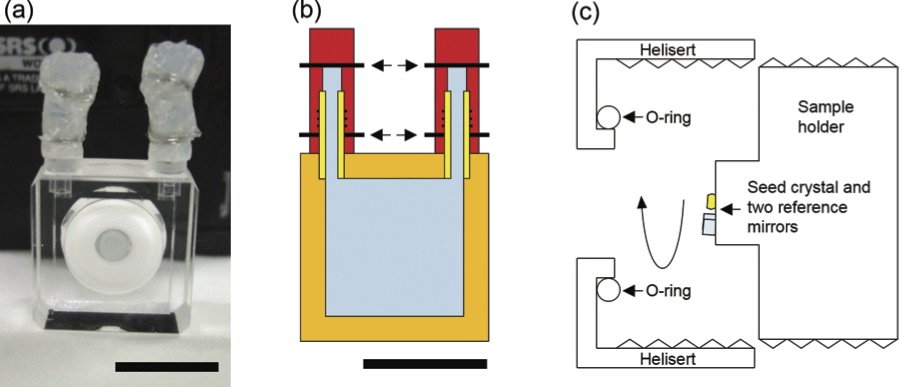Researchers in Japan have grown crystals and measured the growth rate on the ISS by interferometry to better examine the effects of microgravity
From the Journal: Review of Scientific Instruments
Washington, D.C., March 15, 2016 – Sometimes, distance can lend a new perspective to a problem. For Japanese researchers studying protein crystal growth, that distance was 250 miles up – the altitude at which the International Space Station (ISS) orbits the Earth. To better isolate the growth of protein crystals from the effects of gravity, the group of Katsuo Tsukamoto in Tohoku University’s Department of Earth and Planetary Science in Sendai, Japan, and the Japan Aerospace Exploration Agency grew crystals in a specially-designed chamber onboard the ISS.
The researchers monitored the very slow growth and dissolution rate – approximately one 0.01 nanometer per second of the crystals by laser interferometry. This was the first time the technique had been used onboard the ISS to measure the growth rate of the crystals at various temperatures. To observe this, Yamazaki and his colleagues developed unique growth cells suitable for long-term projects, for about six months.
“We are interested in the growth mechanisms of a space-grown protein crystal – a lysozyme crystal – as a model crystal to understand why space-grown crystals sometimes do show better quality than the Earth-grown crystals,” said Tomoya Yamazaki, a PhD student in Tsukamoto’s lab.
Tsukamoto and his colleagues, which includes collaborators at the Japan Aerospace Exploration Agency, Japan Space Forum, Olympus Optical Corporation, detail their elegant growth method this week in Review of Scientific Instruments, from AIP Publishing.
The experimental process, known as NanoStep, was performed in the Japanese Experimental Module (KIBO) of the International Space Station in 2012. Tsukamoto and his colleagues had previously measured the growth rates of protein crystals under simulated microgravity by using a Russian recoverable satellite and aircraft in parabolic flights.
The researchers took precise measurements of the growth rate of the lysozyme crystals versus their driving force, supersaturation – the natural logarithm of the protein’s concentration divided by its solubility – with measurements of the solution’s refractive index distribution obtained through interferometry. This also yielded crucial information about the growth mechanism.
The researchers opted to modify the supersaturation of the solution by increasing or decreasing the growth cell’s temperature, which can easily be done remotely. This took place over a range of 10 – 40 degrees Celsius, which necessitated building a closed growth cell to withstand the stresses caused by the thermal expansion of the growth solution.
The closed, cube-like growth cell was constructed out of quartz glasses with different thickness, an essential component for laser interferometry due to its high chemical and mechanical resistances with a protein seed crystal glued to the top of the sample holder. To relieve the thermal stress on the glass, the researchers attached tubes made out of an elastomer, low-moisture-permeability thermoelastic polymer. This was selected to mitigate evaporation of water in the crystal growth solution, which consisted of 30 or 35 mg/ml of lysozyme and 25 mg/ml sodium chloride in 50 mM sodium acetate buffer solution. They also employed a special spring tension system to reduce stress by keeping the gap between the glass cell and thermal control modules constant amid thermal expansion.

The growth cell could also be used to fine-tune the measurements of extremely small growth or dissolution rates of insoluble minerals on the order of 0.001 nanometers per second of insoluble minerals. For example, it could measure calcium carbonate crystals, where margins of error could become massive across a geological time scale – such as predicting the dissolution of clay minerals surrounding nuclear waste stored underground for 100,000 years.
While the researchers expected growth rates of the crystal solution to be slower because of the suppression of solution convection, the results instead showed an increased growth rate.
This may be due to the suppression of transport speed of impurity molecules with larger diameter to the growing crystal, as analyzed the growth rate versus supersaturation relations. This will appear in forthcoming papers.
Extended projects for the researchers using the same apparatus to test the growth of different crystals, such as glucose isomerase crystals, are currently in preparation.
###
For More Information:
AIP Media Line
media@aip.org
301-209-3090
Article Title
Development of compartment for studies on the growth of protein crystals in space
Authors
T. Yamazaki, K. Tsukamoto, K. Oshi; I. Yoshizaki; S. Fukuyama; H. Miura, T. Shimaoka, T. Maki, and Y. Kimura
Author Affiliations
Department of Earth Science, Graduate School of Science, Tohoku University; Japan Aerospace Exploration Agency; Advanced Engineering Services Co., Ltd, Ibaraki, Japan; Japan Space Forum; Olympus Optical Co.; Institute of Low Temperature Science, Hokkaido
